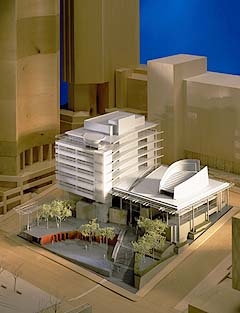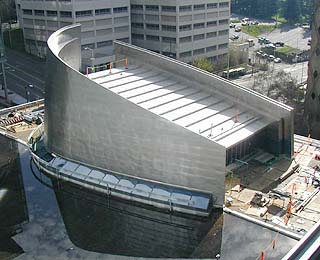|
Subscribe / Renew |
|
|
Contact Us |
|
| ► Subscribe to our Free Weekly Newsletter | |
| home | Welcome, sign in or click here to subscribe. | login |
Construction
| |
 |
April 17, 2003
An approachable landmark for Seattle
Bassetti Architects/Bohlin Cywinski Jackson

Photo courtesy of BA/BCJ The new City Hall, with its large glass lobby and generous plaza, is intended to create a space that encourages public interaction. |
A dignified new symbol of the city and its people — that was the goal set for the creation of the new Seattle City Hall.
Beyond a technologically capable, seismically sound and energy-efficient new home for city government, the team of Bassetti Architects and Bohlin Cywinski Jackson took on an additional charge to design a building that is at once welcoming and approachable, but also a memorable downtown landmark.
As the centerpiece of the new civic center, an integrated campus of city facilities, the new City Hall will act as a nexus, unifying the complex with a visible, public space and single arrival point from multiple approaches.
At the street level of Fifth Avenue, the City Hall main lobby is convenient to workers in city-owned Key Tower and the recently opened Justice Center. Rising from this plateau, a great glass pavilion will welcome citizens, employees, and visitors from around the globe with sweeping views of Puget Sound and the Olympic Mountains, looking back toward historic Pioneer Square.
City Hall will also overlook the varied landscape of the City Hall plaza, designed by Gustafson Partners with Swift & Co. This plaza will celebrate its urban and natural Northwest context with stone terraces, quiet gardens, rippling water and a sweeping civic stairway.
A multifaceted space that welcomes gatherings large and small, quiet or loud, the plaza shapes a public realm that sweeps right into the main lobby. Flowing across the street from its source in the new Justice Center, a water channel ripples through the City Hall lobby, cascading alongside the grand stairway down to the plaza, and continuing across Fourth Avenue to the third block of the new civic center. Water, such a key feature of life in Seattle, will take many forms as it moves through this landscape, including pools and fountain jets, which respond to the intensity of falling rain.
Against the backdrop of its towering neighbors, the new building asserts itself through massing and articulation. According to the city’s master plan, developed by Weinstein Copeland and Hewitt Architects, building mass and height was pushed north to allow maximum sunlight to reach the plaza.
This set the location of the executive office block, which, together with the façade of the new Justice Center, becomes a sleek glass backdrop to frame the titanium-clad form of the Council chamber. This gleaming volume becomes the heart of the composition, a symbol of democracy clearly visible to the wider city.
While rounded to evoke gathering and engage all participants around a common discourse, it is not a closed form. Solid metal arcs pierce the roof behind the Council dais to one side and citizen seating to the other. The side walls are glass, underscoring that meetings in the chamber are open and public.

Photo courtesy of BA/BCJ The titanium-clad Council chamber forms the heart of City Hall and the surrounding civic center.
|
By orienting seating along the long axis, small sessions feel intimate, despite the room’s large capacity. Large doors to the surrounding ambulatory allow for overflow. Video feeds to other building spaces, to the city’s cable- and Web-access channel, and direct to local news media, increasing the inclusiveness of the new chamber far beyond its physical capacity.
The executive office block, rising to the north, houses the City Council and mayor’s offices. Each face of the office block is shaped by its natural and urban context, with stone to the northeast echoing the Justice Center, a southeastern glass arc that responds to the chamber form, and sunshades that articulate and protect the glass of the two westernmost faces.
Each of these sides, as well as the glazed canopy of the roof, is articulated as an independent floating plane, open at the corners. These distinct elements shape the greater whole.
Linking these two volumes, executive and legislative, the public space of the great glass lobby expresses the integral role of citizens and community groups throughout Seattle’s government.
Here, slender columns soar upward to support a lattice of steel and wood, sheltering this portion of the plaza from rainy days, while the transparent glass of the enclosure, skylights, and canopies reconnect this space with Seattle’s ever-changing cloudscape.
This double-height space is an indoor civic square, a place of chance encounter and spontaneous assembly. Citizens and elected officials may meet while crossing “Blue Passage,” a structural glass bridge by artist James Carpenter that spans the lobby.
Seating steps on the great limestone stairway up to the Council chamber offer seating for events or casual places for people to perch throughout the day. A glass art wall by lead artist Beliz Brother follows the arc of the chamber above to a more intimate room with a granite fireplace and then to a generous, glazed public reception space overlooking the plaza.
The rest of the public lobby is open and flexible for city cultural programming, gallery and gathering space. If City Hall is the city’s house, this grand space is its living room, open and welcoming, a shining beacon to the city at night.
Realizing this ambitious program involved many challenges, all of which held opportunities that contributed to the shape of the final building. Public feedback helped to adjust and shape the design throughout, strengthening and refining the design and contributing to a lasting source of community pride. Physical and economic constraints played a significant role too.
In the end the most important charge was perhaps to express the city’s spirit and make city government apparent to the public at large — to make a celebratory space for the people of Seattle. Unlike its utilitarian predecessor, the new City Hall expresses its civic purpose and regional circumstance with a traditional vocabulary of civic elements and proportions reinterpreted for today.
Seattle’s new City Hall will stand before Puget Sound as a space of action, reflection and interaction, inclusive and welcoming of all.
and building programming efforts. Sergei Bischak is an associate with Bohlin Cywinski Jackson and a project manager for the new City Hall. Todd Lynch is an architect with Bohlin Cywinski Jackson, and led the early design.
Other Stories:
- Leaving behind an 'abomination'
- We heard you loud and clear
- A building for Seattle's next 100 years
- Complex project requires bold solutions


